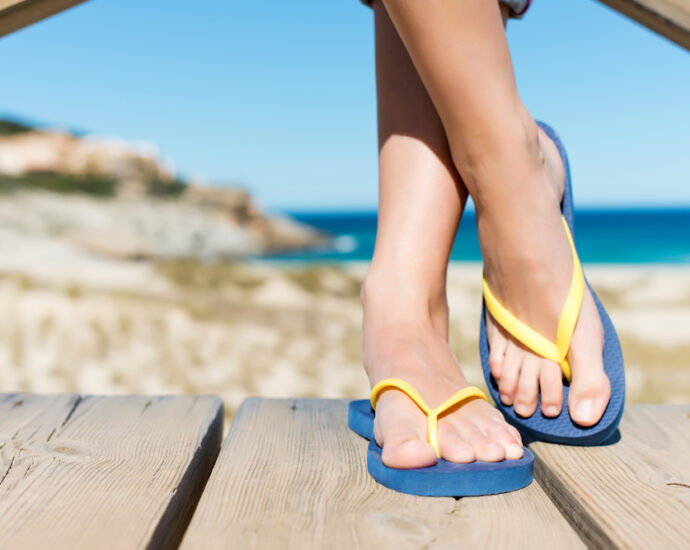Taking care of your feet is important not only for your overall health but also your mobility. Let’s face it when our feet hurt it affects our whole body.
Page Contents
How do you determine your shoe size?
Determining your shoe size accurately is important for comfort and proper foot health.
Here’s a step-by-step guide on how to measure your shoe size:
What You’ll Need:
- A piece of paper
- A ruler or measuring tape
- A pair of socks you intend to wear with the shoes
Steps to Determine Your Shoe Size:
- Find a Flat Surface: Ensure you have a flat and even surface on which to take measurements.
- Prepare the Paper: Place a piece of paper on the floor and position it so that one edge is flush against a wall or straight surface. Make sure the paper doesn’t wrinkle or fold.
- Put on Your Socks: If you intend to wear socks with the shoes, put them on now. It’s important to measure your feet with the same type of socks you plan to wear.
- Step onto the Paper: Stand on the piece of paper with your heel against the wall or straight surface. Make sure your weight is evenly distributed on both feet.
- Mark Your Foot: Use a pen or pencil to mark the point at the tip of your longest toe (usually your big toe). If you’re unsure which toe is longest, you can wiggle your toes to find out.
- Measure the Length: Use a ruler or measuring tape to measure the distance from the edge of the paper to the mark you made. This measurement represents the length of your foot.
- Repeat for Both Feet: It’s common for one foot to be slightly larger than the other. Measure both feet and use the measurement from the longer foot when determining your shoe size.
- Convert to Shoe Size: Once you have the measurements in inches or centimeters, you can use a shoe size conversion chart. Different regions (e.g., US, UK, EU) have different sizing systems, so make sure to use the appropriate chart. Online shoe retailers often provide size conversion charts on their websites.
- Consider Width: Shoe sizes typically include both length and width measurements. If you have wider or narrower feet, look for shoes with the appropriate width designation (e.g., “W” for wide or “N” for narrow).
- Try Shoes On: Even if you have your measurements, it’s a good idea to try shoes on before purchasing, especially if you’re buying a new brand or style. Comfort and fit can vary between shoe brands and models.
Remember that your shoe size can change over time due to factors such as age, weight fluctuations, and pregnancy. It’s essential to measure your feet periodically to ensure you’re wearing the correct size for optimal comfort and foot health. If you’re unsure about your size, consider visiting a shoe store with knowledgeable staff who can assist you in finding the right fit.
Easy steps to keep your feet healthy:
Keeping your feet healthy is crucial for overall well-being and mobility. Here are some easy steps to help you maintain healthy feet:
Daily Cleaning:
Wash your feet with mild soap and warm water daily, paying attention to spaces between your toes.
Gently pat your feet dry, especially between the toes, to prevent moisture buildup.
Proper Nail Care:
Trim your toenails straight across, avoiding rounded edges to prevent ingrown toenails.
Use a clean, sharp nail clipper, and file the edges if needed.
Moisturize:
Apply a moisturizing foot cream or lotion to keep the skin on your feet soft and prevent dryness and cracking. Avoid applying lotion between your toes to prevent fungal growth.
Footwear Selection:
Wear shoes that fit properly and provide adequate support for your arches and heels.
Choose shoes with breathable materials to prevent excessive moisture and odors.
Rotate your shoe choices to allow them to air out between wears.
Sock Selection:
Opt for moisture-wicking socks made of natural fibers like cotton or bamboo.
Change your socks daily, especially if they become damp from sweating or moisture.
Foot Protection:
Use sunscreen on your feet when exposed to the sun to prevent sunburn.
Wear appropriate footwear for activities that could lead to foot injuries, such as sports or hiking.
Proper Foot Hygiene:
Keep your feet clean and dry, especially after exercise or exposure to water.
Avoid walking barefoot in public places to reduce the risk of fungal or bacterial infections.
Regular Foot Inspections:
Check your feet daily for any cuts, blisters, sores, or changes in skin color or temperature. Use a mirror if needed.
Foot Exercises:
Perform simple foot exercises like toe stretches and ankle circles to improve flexibility and strengthen foot muscles.
Roll a tennis ball or golf ball under your feet to relieve tension and improve circulation.
Elevate Your Feet:
When sitting, elevate your feet to reduce swelling, especially after a long day of standing or if you have foot pain.
Maintain a Healthy Weight:
Excess weight can put added stress on your feet. Maintain a healthy weight through a balanced diet and regular exercise.
Footwear Inserts (Orthotics):
Consider using orthotic inserts or insoles if you have specific foot issues or need extra arch support. These can improve comfort and reduce strain on your feet.
Seek Professional Care:
If you have foot pain, persistent issues, or diabetes, consult a podiatrist (foot specialist) for proper care and advice.
Stay Hydrated:
Proper hydration helps maintain overall skin health, including the skin on your feet.
Listen to Your Feet:
Pay attention to any unusual sensations, pain, or discomfort in your feet. These can be early signs of underlying issues that require attention.
Remember that simple daily habits can go a long way in maintaining healthy feet. By following these steps, you can prevent many common foot problems and enjoy better foot health.
Sources:
https://www.healthyfeetstore.com/shoe-fitting-guide.html?gclid=Cj0KCQjw9fqnBhDSARIsAHlcQYQAR6H0YJIvaVKB1aBjFp6ihCrHgNnR3cgiS7t1C_ZIiWz60d7IB0UaAsLAEALw_wcB
https://healthsurgeon.com/calculate/ideal-healthy-weight/
https://www.uclahealth.org/news/happy-feet-10-tips-for-maintaining-healthy-feet
